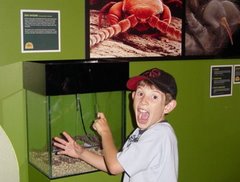Digital Eva asks:
"I am also looking (or this is what basically my project aim) at how designer could design a tool in assisting summative evaluation by integrating drawings as the medium to reveal or gather information about audiences' experience."
I have used drawings quite successfully when evaluating exhibitions - it's a great tool for both adults and children. When I evaluated the Indigenous Australians exhibition I gave people a blank page with one question: "Draw how the exhibition made you feel". The responses were really amazing. As part of a front-end evaluation we asked children aged from 2-6 years to keep a journal of their museum experiences. The results were quite incredible as they mixed drawings with photos that they had taken thoughout the Museum. As part of our current research project, Culturally Diverse Audiences and Museums, we again used the journal method, this time to record participants' leisure activities and where museums fitted within their lives. In this study we also used photographs when interviewing people post-visit as a way to prompt memories of their experiences and as a deeper way to discuss their visit. They were photos that they had taken.
Also when doing a trawl, came across this useful resource Social Research Update published quarterly by the Department of Sociology, University of Surrey. There is an article there Visual research methods, although a tad old it has some interesting ideas. The article Using diaries in social research is also really good and relevant too.
I think that drawing and visual methods are a really good tool, especially when coupled with interviews (as you still need to get them to interpret their material). I'm wondering if there are any other examples out there??
Subscribe to:
Post Comments (Atom)



5 comments:
Now I'm at work I have another reference for using visuals in research:
Emmison, M. & Smith, P. (2000). Researching the Visual: Images, Objects, Contexts and Interactions in Social and Cultural Inquiry. London: Sage.
I have used drawings as part of a couple of front-end evaluation projects with children.
Drawing helps those children who are more visually oriented to express themselves happily. And it gives the fidgety doodlers something to do while others are talking.
So, the output is relevant to the project because useful information is gathered and the activity also helps the interview process by giving another avenue for expression.
I am particularly interested in high quality information gathering. In depth methods should provide a variety of ways for our research participants to express themselves, and drawing is one of those creative forms that encourages deeper engagement.
Thank you for the respond Lynda. It's very useful for me as a beginner. I have couples of your writings in my project documentation. I hope to communicate further through email if possible.
Thanks Eva - happy to be of help, that's what I'm testing this blog out for. Also cool to be contacted by email, or via the blog as then you get the advantage of Gillian's expertise too!
Dear Lynda,
I'm wondering if there any precise and comprehensive guide of evaluation process available. At this point, the information that I have is just basic. Is the evaluation process in museum exhibits different than other kind of evaluation process?
I found a text fromNational Science Foundation. It's called 'The 2002 User0Friendly Handbook for Project Evaluation'. Can this be applicable to museum evaluation too?
Thanks Lynda.
Post a Comment